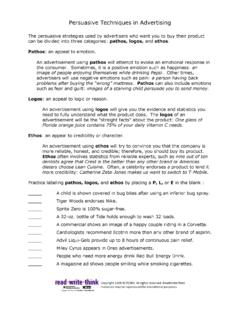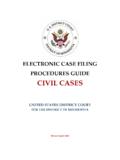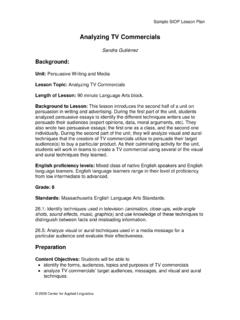Transcription of Creating Persuasive and Effective Visuals - LearnAlberta.ca
1 Creating Persuasive and Effective Visuals This modelling the tools is incorporated into critical challenges at grades 4, 5, 7, 8, 11 and 12, however, it can be adapted for use at all grade levels. Overview These activities will help students explore the Persuasive qualities of various media and the techniques used to create these qualities. Students will be able to use Persuasive techniques so that they can advertise an issue, topic or event. First students learn about the techniques of persuasion and then they discuss two purposes of advertising: to create a powerful impression in a short period of time, and to inform people about a topic or issue. Students will analyze samples of print ads in order to identify techniques that were used and their impact on viewers.
2 Finally, students will use what they have learned to create Persuasive and Effective Visuals . Preplanning Assemble sample Visuals . Gather several posters that illustrate Effective visual techniques; , travel posters, library posters, fitness posters. Gather a selection of advertisements from magazines or ask students to bring copies of advertisements to class. Ask students to photocopy, print or download images they find as they conduct research or coursework. Alternatively, you may wish to direct students to online resources that include a rich variety of visual images, such as those located in Samples of Advertising Posters A or Samples of Advertising Posters B. Remind students to cite sources correctly.
3 Session One Introduce the assignment. Explain that students will be Creating Visuals , , posters, flyers, ads, collages, to persuade a designated audience to take action on a particular issue or topic. Discuss the main communicative purpose of advertising, whether in newspapers, or on radio, television or the Internet. Elicit the idea that advertisements try to persuade people to do something; , buy a specific brand of cola, convince people not to drink and drive, or persuade people to donate money to a cause. Indicate that the class is going to learn about Persuasive techniques and to examine the qualities of Effective visual forms of advertising. Introduce techniques of persuasion.
4 Distribute to each student a copy of Persuasion Techniques in Advertising. Review the concept of techniques ways to achieve the desired results. You may wish to ask Page 1 of 8 2010 Alberta Education ( ) individual students to read aloud the descriptions of each technique. As they go through each one, ask students if they can think of examples of ads that use these forms of persuasion. Identify Persuasive techniques. Invite students to examine the posters you assembled or the advertisements they brought to class. Ask them to identify the Persuasive techniques illustrated in the examples; , buzzwords, bandwagon. Invite students to comment on the effectiveness of the Persuasive techniques.
5 You may wish to have students use sticky notes to label the techniques. Ask students if they can identify any additional techniques not described in Persuasion Techniques in Advertising. To address ICT outcomes, students can paste digital images of advertisements and posters into an electronic document and label the images using callout features of their software (see Identifying Persuasion Techniques Example). You may wish to ask students to find examples of Effective ads that employ one or more of the Persuasive techniques listed in Persuasion Techniques in Advertising. Introduce ad analysis. Distribute one or two copies of Advertising Analysis to each student. Discuss and list qualities/criteria for Effective advertisements; , captivating, Persuasive , informative.
6 Using the collection of various ads and posters, ask students to note the techniques used to make the ads Effective . Invite students to suggest an ad for group analysis. As a class, discuss the techniques used for the qualities/criteria and the reasons why these techniques are Effective . Session Two Develop criteria for Effective Visuals . Remind students that persuasion is only one of the purposes of advertising. Point out that ads also need to create a powerful impression in a short time and to inform people about the topic. Visuals are an Effective way to do this because our brain remembers images better than it does text. Suggest the following qualities/criteria of Effective Visuals : o catchy: grabs the audience's attention o concise: brief; requires as little reading as possible o comprehensive: presents all the key information; , stakeholders, interests, issue, relevant data o convincing: makes viewers believe that the information on the visual is important and reliable.
7 Discuss visual techniques. List on the board the four qualities/criteria for an Effective visual and record additional techniques that students identify. Page 2 of 8 2010 Alberta Education ( ) Creating an Effective visual Qualities Techniques catchy bold headings snappy captions provocative images colour concise point form, not full sentences uses images to communicate comprehensive titles and headings short passages of text uses captions to explain convincing provocative images powerful phrases supported with facts famous people Analyzing Visuals Distribute Visuals such as flyers, posters, and magazine advertisements. Ask students to work with a partner to examine a variety of Visuals to find evidence for each of the four criteria of Effective Visuals (catchy, concise, comprehensive, convincing).
8 See Analyzing Visuals Example. You may wish to have students use copies of Analyzing Visuals for Effectiveness to structure the activity. Page 3 of 8 2010 Alberta Education ( ) Analyzing Visuals for Effectiveness Criteria for Effective Visuals Evidence Explanation (why it works) Catchy (grabs the audience's attention) Concise (brief) Comprehensive (presents all the key information) Convincing (makes the viewers believe the information on the visual is important and believable) Session Three Introduce the challenge. Ask students, individually or in pairs, to undertake the critical task: Design a Persuasive and Effective visual to convince others to take action on your issue.
9 Students should apply what they have learned about advertising techniques to create a Persuasive and Effective poster, advertisement, brochure, collage or electronic slide show presentation. Design the visual . Suggest that each student or team proceed in the following manner to develop its visual : 1. Identify an issue. 2. Determine or review the key concepts of the issue that should be represented on the visual . 3. Think about the characteristics and needs of the audience. 4. Plan possible Persuasive technique(s). 5. Identify the methods to be used to produce an Effective visual . 6. Prepare a rough draft of the visual . Consider printing the text on sticky notes or slips of paper and then organize the text and images without attaching them permanently.
10 7. Participate in a peer review (see Session Four). 8. Revise the draft visual in response to the peer feedback and to ensure that it meets the four criteria identified previously. 9. Complete the final copy of the poster. Page 4 of 8 2010 Alberta Education ( ) You may want students to complete a Visuals Planning Checklist to assist them in identifying the techniques they will use. Session Four Organize peer review. Distribute a copy of Constructive Feedback to each student. Arrange students in pairs to review each other's draft visual . Explain that, in the first section, students are to identify positive aspects/qualities and provide evidence for how the techniques were Effective in achieving these qualities For example, a student might note that one of the strengths is that the visual is catchy.

















